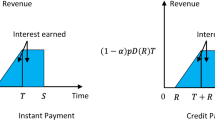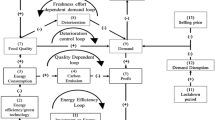Abstract
Considering that more than 100 million EU citizens face the risk of poverty or social exclusion, while at the same time 35% of perishable food in the EU is unnecessarily discarded at supermarkets, the redistribution of the perishable food surpluses could provide an economically feasible solution towards the confrontation of poverty and the minimization of food waste. Under this context, the purpose of this paper is to propose a novel quantitative decision-making tool that optimizes a retailer’s replenishment policy for perishable products while minimizing the amount of perishable items discarded after they approach their expiration dates, through the timely donation of a part of their net stocks.

Similar content being viewed by others
Explore related subjects
Discover the latest articles and news from researchers in related subjects, suggested using machine learning.References
Aiello, G., Enea, M., & Muriana, C. (2014). Economic benefits from food recovery at the retail stage: An application to Italian food chains. Journal of Waste Management, 34(7), 1306–1316.
Aiello, G., Enea, M., & Muriana, C. (2015). Alternatives to the traditional waste management: Food recovery for human non-profit organizations. International Journal of Operations and Quantitative Management, 21(3), 215–239.
Amorim, P., Costa, A. M., & Almada-Lobo, B. (2014). Influence of consumer purchasing behaviour on the production planning of perishable food. OR Spectrum, 36(3), 669–692.
Avinadav, T., Herbon, A., & Spiegel, U. (2013). Optimal inventory policy for a perishable item with demand function sensitive to price and time. International Journal of Production Economics, 144(2), 497–506.
Azhar, A. R., Mohd Salehuddin, M. Z., Mohd Faeez, S. B., & Mohd Syaquif, Y. K. (2012). Customer satisfaction with hypermarket fresh food’s characteristics. Journal of Tourism, Hospitality & Culinary Arts, 4(1), 17–37.
Bai, R., & Kendall, G. (2008). A model for fresh produce shelf-space allocation and inventory management with freshness-condition-dependent demand. INFORMS Journal on Computing, 20(1), 78–85.
Bakker, M., Riezebos, J., & Teunter, R. H. (2012). Review of inventory systems with deterioration since 2001. European Journal of Operational Research, 221(2), 275–284.
Bhattacharjee, S., & Ramesh, R. (2000). A multi-period profit maximizing model for retail supply chain management: An integration of demand and supply-side mechanisms. European Journal of Operational Research, 122(3), 584–601.
Chang, C. T., Teng, J. T., & Goyal, S. K. (2010). Optimal replenishment policies for non-instantaneous deteriorating items with stock-dependent demand. International Journal of Production Economics, 123(1), 62–68.
Chen, S. C., Min, J., Teng, J. T., & Li, F. (2016). Inventory and shelf-space management for fresh produce with freshness-and-stock dependent demand and expiration date. Journal of the Operational Research Society, 67(6), 884–896.
Chern, M. S., Yang, H. L., Teng, J. T., & Papachristos, S. (2008). Partial backlogging lot-size models for deteriorating items with fluctuating demand under inflation. European Journal of Operational Research, 191(1), 127–141.
Chun, Y. H. (2003). Optimal pricing and ordering policies for perishable commodities. European Journal of Operational Research, 144(1), 68–82.
Chung, K. J., Cárdenas-Barrón, L. E., & Ting, P. S. (2014). An inventory model with non-instantaneous receipt and exponentially deteriorating items for an integrated three layer supply chain system under two levels of trade-credit. International Journal of Production Economics, 155, 310–317.
Dye, C. Y., & Ouyang, L. Y. (2005). An EOQ model for perishable items under stock-dependent selling rate and time-dependent partial backlogging. European Journal of Operational Research, 163(3), 776–783.
European Economic and Social Committee. (2014). Comparative study on EU Member States’ legislation and practices on food donation. Executive summary. http://www.eesc.europa.eu/resources/docs/executive-summary_comparative-study-on-eu-member-states-legislation-and-practices-on-food-donation.pdf.
European Federation of Food Banks (FEBA). (2013). EU Programs. https://www.eurofoodbank.org/poverty-waste/eu-programs.
European Federation of Food Banks (FEBA). (2015). Food banking an efficient model. https://www.eurofoodbank.org/food-banking/an-efficient-model.
European Parliament and Council of the European Union. (2004). Regulation (EC) No 852/2004. http://eur-lex.europa.eu/LexUriServ/LexUriServ.do?uri=OJ:L:2004:139:0001:0054:en:PDF.
Feng, L., Chan, Y.-L., & Cardenas-Barron, L. E. (2017). Pricing and lot-sizing polices for perishable goods when the demand depends on selling price, displayed stocks, and expiration date. International Journal of Production Economics, 185, 11–20.
Gallego, G., & van Ryzin, G. (1994). Optimal dynamic pricing of inventory with stochastic demand over finite horizons. Journal of Management Science, 40, 999–1020.
Geetha, K. V., & Uthayakumar, R. (2010). Economic design of an inventory policy for non-instantaneous deteriorating items under permissible delay in payments. Journal of Computational and Applied Mathematics, 233(10), 2492–2505.
Ghare, P. M., & Schrader, G. F. (1963). A model for an exponential decaying inventory. Journal of Industrial Engineering, 14, 238–243.
Goyal, S. K., & Giri, B. C. (2001). Recent trends in modelling of deteriorating inventory. European Journal of Operational Research, 134(1), 1–16.
Karaesmen, I. Z., Scheller-Wolf, A., & Deniz, B. (2011). Managing perishable and aging inventories: Review and future research directions. In: Kempf, K., Keskinocak, & P., Uzsoy, R. (Eds.), Planning production and inventories in the extended enterprise. International series in operations research and management science (Vol. 151, pp. 393–436). Boston, MA: Springer.
Lee, D., & Tongarlak, M. N. (2017). Converting retail food waste into by-product. European Journal of Operational Research, 257(3), 944–956.
Minner, S., & Transchel, S. (2017). Order variability in perishable product supply chains. European Journal of Operational Research, 260(1), 93–107.
Moon, I., Giri, B. C., & Ko, B. (2005). Economic order quantity models for ameliorating/deteriorating items under inflation and time discounting. European Journal of Operational Research, 162(3), 773–785.
Muriana, C. (2016). An EOQ model for perishable products with fixed shelf life under stochastic demand conditions. European Journal of Operational Research, 255(2), 388–396.
Nahmias, S. (1982). Perishable inventory theory: a review. Operations Research, 30(3), 680–708.
Piramuthu, S., & Zhou, W. (2013). RFID and perishable inventory management with shelf-space and freshness dependent demand. International Journal of Production Economics, 144(2), 635–640.
Raafat, F. (1991). Survey of literature on continuously deteriorating inventory model. Journal of the Operational Research Society, 42, 27–37.
Schneider, F. (2013). The evolution of food donation with respect to waste prevention. Journal of Waste management, 33(3), 755–763.
United States Environmental Protection Agency (EPA). (2016). Reduce wasted food by feeding hungry people. https://www.epa.gov/sustainable-management-food/reduce-wasted-food-feeding-hungry-people.
Vaughan, T. S. (1994). A model of the perishable inventory system with reference to consumer- RealizedProduct expiration. Journal of the Operational Research Society, 45(5), 519–528.
Wang, W. C., Teng, J. T., & Lou, K. R. (2014). Seller’s optimal credit period and cycle time in a supply chain for deteriorating items with maximum lifetime. European Journal of Operational Research, 232(2), 315–321.
Wu, J., Chang, C. T., Cheng, M. C., Teng, J. T., & Al-khateeb, F. B. (2015). Inventory management for fresh produce when the time-varying demand depends on product freshness, stock level and expiration date. International Journal of Systems Science: Operations & Logistics, 3(3), 138–147.
Wu, J., Ouyang, L. Y., Cárdenas-Barrón, L. E., & Goyal, S. K. (2014). Optimal credit period and lot size for deteriorating items with expiration dates under two-level trade credit financing. European Journal of Operational Research, 237(3), 898–908.
Wu, K. S., Ouyang, L. Y., & Yang, C. T. (2006). An optimal replenishment policy for non-instantaneous deteriorating items with stock-dependent demand and partial backlogging. International Journal of Production Economics, 101(2), 369–384.
Author information
Authors and Affiliations
Corresponding author
Appendix 1
Appendix 1
Our optimizations process initially involves the derivation of each one of the profit function components separately, as these are summarized below:
Since:
-
\( \frac{{\partial \varPhi_{\varUpsilon} (z_{{q_{0}}})}}{{\partial q_{0}}} = \varphi_{\varUpsilon} (z_{{q_{0}}}) \cdot \frac{{\partial \cdot z_{{q_{0}}}}}{{\partial q_{0}}} \)
-
\( \frac{{\partial \varphi_{\varUpsilon} (z_{{q_{0}}})}}{{\partial q_{0}}} = - z_{{q_{0}}} \cdot \varphi_{\varUpsilon} (z_{{q_{0}}}) \cdot \frac{{\partial \cdot z_{{q_{0}}}}}{{\partial q_{0}}} \)
-
\( \frac{{\partial (Q-{q_0})}}{{\partial q_{0}}} = -1 \)
and by differentiating, each function with respect to \( q_{0} \), considering the following Leibnitz rule:
we obtain:
By applying the first order conditions leads to:
Finally, by solving with respect to \( q_{0} \), further leads to
In order to prove that the first order conditions are satisfied, then:\( \frac{{\partial^{2} E(Profit_{T})}}{{(\partial q_{0})^{2}}} < 0 \). Thus
As \( (p - s + b) \cdot {\varphi_{\varUpsilon}} ({z_{q_{0}}}) \) is always positive, the first order conditions are satisfied if and only if the following inequality is also satisfied:
Rights and permissions
About this article
Cite this article
Mallidis, I., Vlachos, D., Yakavenka, V. et al. Development of a single period inventory planning model for perishable product redistribution. Ann Oper Res 294, 697–713 (2020). https://doi.org/10.1007/s10479-018-2948-2
Published:
Issue Date:
DOI: https://doi.org/10.1007/s10479-018-2948-2
Keywords
Profiles
- Ioannis Mallidis View author profile




